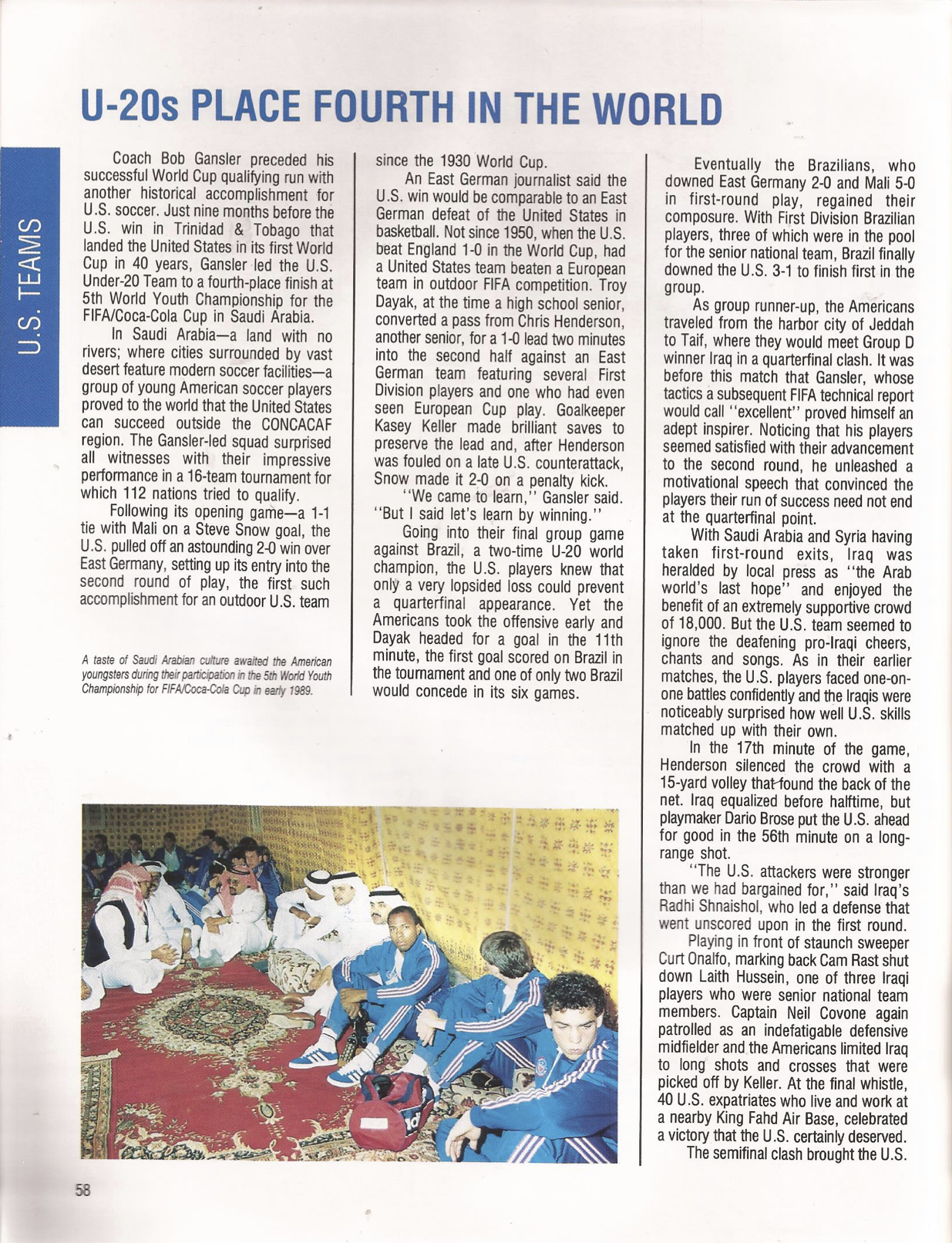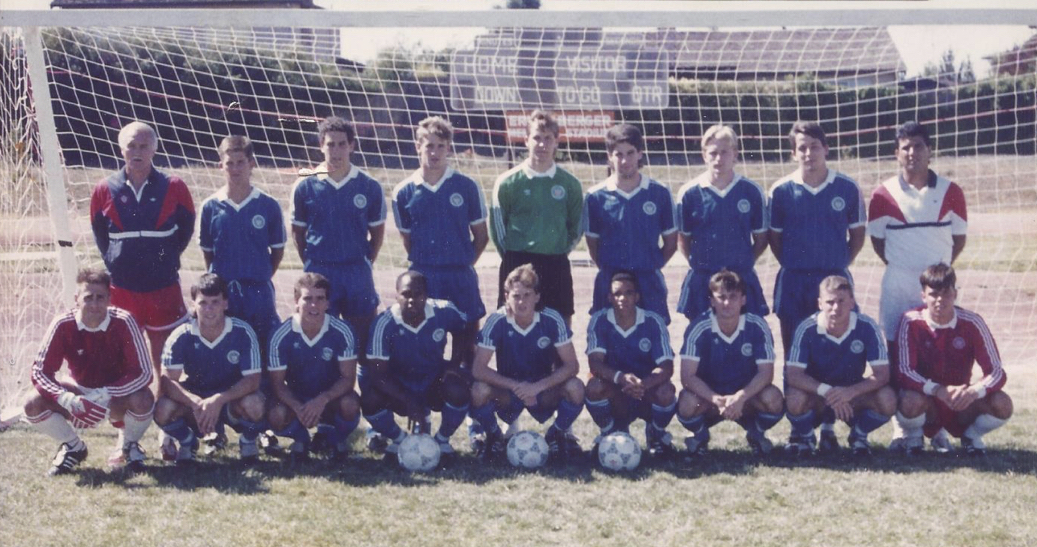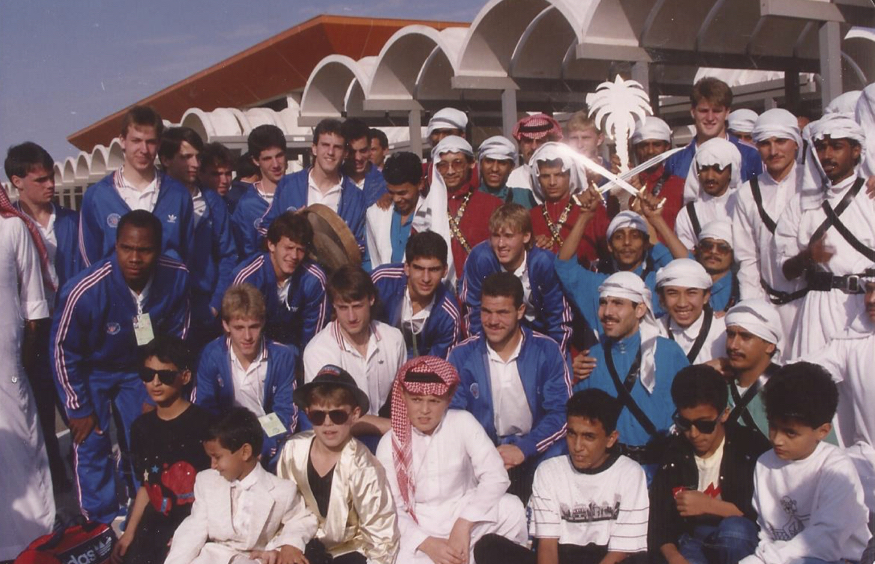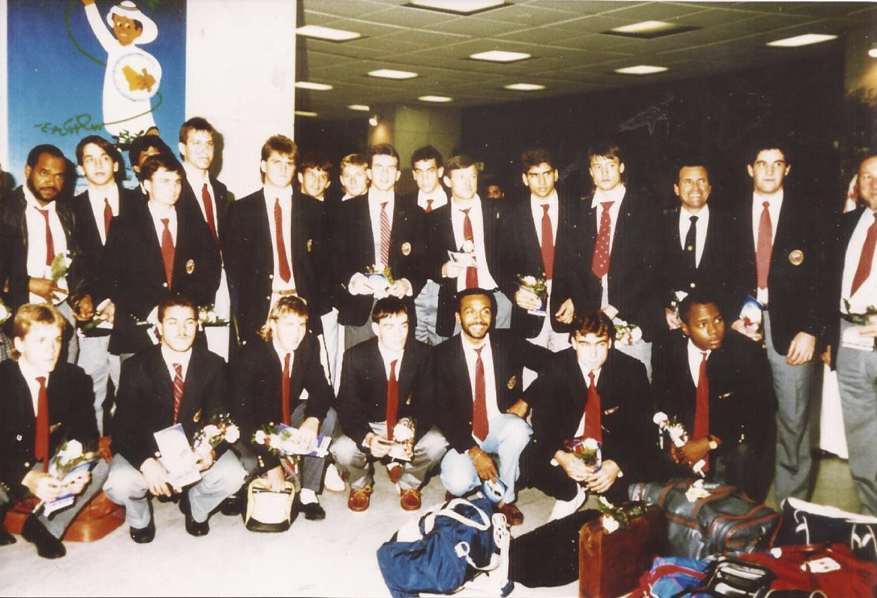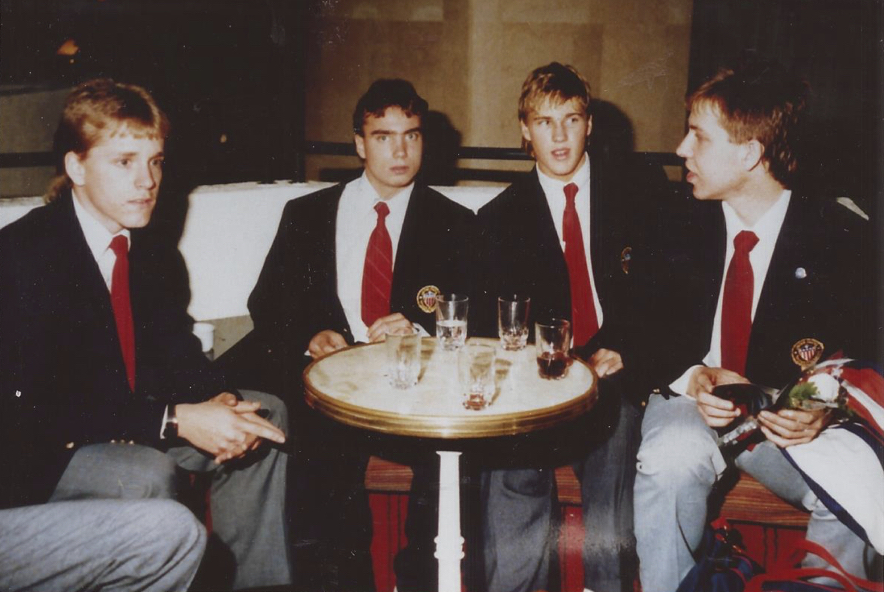1989 was a historic year for US soccer. Not only would the senior team return to the World Cup stage for the first time since 1950, but the U20s quietly had the best performance of any team before or since. The 1989 tournament saw the US finish fourth, losing to Nigeria in the knockout stage in overtime. However, the trip to the U20 World Cup began in bizarre fashion. Originally the American team did not qualify for the tournament, losing out to Costa Rica and Mexico. Soon after, rumors of Mexico using overage players during qualifying began to surface. FIFA came down heavy on Mexico, banning them from the U20 World Cup as well as the senior World Cup in 1990. (More on the scandal can be read here.) With Mexico removed, the third place team, USA, would take Mexico's place at the tournament in Saudi Arabia.
The two goalkeepers that travelled to Saudi Arabia would be future USMNT goalkeeper Kasey Keller and Markus Roy, who was a freshman at Northern Illinois at the time. Markus recounts memories from the World Cup, now seventeen years ago this February. Scroll down to the bottom to see memorabilia and photos that Markus did a great of job of holding on to from the tournament.
What was the qualifying process like, after initially not qualifying then hearing that you would be going to the U20 World Cup?
At the time, [qualifying] was in Guatemala. We trained in Mexico for some training and some friendly games. It was against Canada and... I’m trying to think... I want to say it was for a week, before qualifications, just to get used to the altitude and this and that. I think at that time either Coach [Bob] Gansler or Coach Perez, I’m assuming it was Coach Gansler, had the Mexican pro league’s big manual of all the teams and photos and players. It was a good scouting tool for Coach Gansler at the time and we didn’t think anything of it but he was looking at the players because it was basically a free, you know. You could look at all the players and what teams they played for and it gave their real age. So I think Coach Gansler used that to his advantage.
We ended going to Guatemala and obviously we didn’t qualify at the time but I think on the way to the airport, they told Kasey and I, “We’ll be seeing you guys again about all the stuff so don’t let it get you down.”
I’m not sure what time of year that was or when that happened but I don’t think we thought anything of it. We got a call - I’m not sure how much longer after the qualifying round - that said, “Get ready to go. We’re going to qualify.” So it was pretty exciting obviously for the players from not qualifying to having a team disqualified for using ineligible players.
What was your time like playing with Kasey Keller?
He was there, I think, a couple three years before me, maybe more. So he had always been there and always was there, for years afterwards, obviously. I came in and I beat out their best backup. I’m not sure who it was. They always had goalies there so you never knew if you were going to be the backup or the starter, which is good. I think it even made Kasey work that much harder because he didn’t look at it like he was the starting goalie the whole time. He was really positive about anyone playing. I texted Kasey a couple months ago and I showed him one of those pictures I showed you. One of those from Russia or something. So that was pretty cool, back in the day. *laughs* But I think that’s how he was as a pro. He worked harder every day and it made me a better goalkeeper as well. He was always, “We’re a team here.”
What was preparations for the World Cup like?
Well I think it’s probably different now than it was, with all the academies. It’s more year round now. We were always brought together for a couple weeks here, a couple weeks there. And the club soccer was probably different back then for us as well. It wasn’t as developed as the academies are now. Plus a majority of our players, if not all, were collegiate players, playing three-four months out of the year. And February was in our off-season, the [time of the U20] World Cup. So we were not “in season” per se. We were in condition and in shape but I don’t think it’s like it is nowadays. They would fly us in two-three days before and, if I’m remembering, in Saudi Arabia we came in a week before, maybe even longer than that. It wasn’t like we were there for 2-3 weeks, or a month like some teams are now.
I think Bob Gansler was excellent in scouting the opponents, really finding their strengths and weaknesses. And our team knew specifically what their roles were. It was amazing what the players did from Kasey Keller through the defenders, and the rest of the team. I don’t think there were that many superstars on the team at the time.
Group Stage Results:
Mali 1-1
East Germany 2-0
Brazil 1-3
Knockout:
Iraq 2-1
Nigeria 1-2 (aet)
Brazil 0-2
Did the team expect to get out of the group and progress as far as you did or was it somewhat surprising ending up in the fourth place game?
Probably a little bit of both. Because now you see players on social media. There’s all this video on anyone on YouTube. I can Google a kid on the U20 team for Brazil and find it or whatever. At the time, we were just focused on being away for a month and we didn’t really know otherwise. And I thought the guys did a tremendous job. I think one of the biggest games was when we beat the East Germans, which that was a huge upset. And I know our expectations against Brazil were, you know, we didn’t think they were world beaters but obviously a different side than us. Playing against Iraq was more of a political thing where, at the time, we were still pretty young but politically um… I’m trying to think of something to say *laughs* It’s Iraq versus USA. It doesn’t happen very often in any sport. So I think at the time with the world struggles, it was a big thing for their country as well for the US.
Not many highlights have survived the 1989 World Cup. This is the only one involving the US.
USA reached the semifinal game, where they lost in overtime to Nigeria 2-1. What do you remember from the last knockout game?
They were in a lot of youth World Cups and have done real well over the years and they always do real well, the young Nigerian teams. From what I remember from the game, we put everything on the field. All those weeks in Saudi Arabia, we left it on the field. Our tanks were empty and we did the best we could. It was an overtime game and could have gone either way. I think, maybe, they were bigger than us, stronger than us, but we were in the game the whole time. I just think our tanks were empty, which wasn’t a bad thing.
How long did the buzz last when you came back to the US?
You know, it’s unfortunate at the time that there wasn’t any social media, nothing. So it died pretty quickly but you heard it in some soccer rooms. Even today you hear once in awhile, you know, “the best finish for the US was this team” and I’ll think, “yeah I was on that team!” But you don’t hear a lot of it. It’s unfortunate because if the league was around, MLS, when we were playing, I think a few more players, could have made it to the next level and may have gotten a little more recognition. A few guys did a great job in their club careers, Keller obviously being the top player.
I think the buzz is still around for the players who are on the [current U20] team but it’s not so much for anyone else [that played on previous U20 teams], which is fine. Soccer has changed so much. I don’t think there was as much pressure for us to win. I think that’s why one reason we did so well is because we came in as unknown college players. And now the U20 teams, a lot of them are professionals. So it’s a lot different now for Tab Ramos. It’s good and it’s bad but that’s the way soccer has changed around here in the US.
Looking at the pictures, you’re in most of them. Who was taking the pictures?
You know, I want to say it was one of team representatives. I think they had pictures for everybody and I just took the ones I was in. There are a few that I took. Or the ones of Kasey, Troy [Dayak], and myself, I think I had my camera with me and said to one of the players “Hey take a picture of us.”
The pictures of the stadium, which one is that?
Is that the one that kind of looks like a tent?
Yeah, there’s an aerial view and one from inside, which is the same one, I’m pretty sure.
Yeah, that was the third place game. That was in, I think, Riyadh. They had the final at that stadium.
Tell me about the one with the camel and you’re holding some flags. What’s going on there?
That was one of the days we had off and I want to say that was taken by one of the players. I think we all had a chance to ride on the camel. We were away with a couple guys and the people over there in Saudi Arabia, you know, we’re tourists and foreigners, so they’d let us get on the camel for free but to get off the camel you’d have to pay some money. So they kind of suckered us out for that. We got off the camel and the guy was yelling at us but we’re walking away to the bus saying, “We’re done. We’re not paying you. We didn’t know how this worked. We weren’t looking to get scammed for a couple bucks.” But that’s what happened on that one.
Where are you in the picture where there’s water behind you and, I think, a flag pole?
I think that’s got to be uh… oh man, I want to say… I think it’s the Red Sea. One of those seas that we took a walk and it was a nice day and I remember even that day as well that it rained and it never rains there. Like when we have a snow day in Chicago, kids don’t go to school here but when it rains outside [in Saudi Arabia] they let the kids go home to go play in the rain. You can see the clouds in the sky there, which doesn’t happen a lot, I guess.
We did a lot of that stuff. We didn’t go out a lot during the day because it was so hot. But that day was overcast a bit and not so hot.
There’s another one where you all have an Arab headdress on. What was the reason for the photo there?
So that was at the hotel. We played in two or three different cities and every city we got a little gift bag or something from that area. And that’s one of those headdresses. From what I remember, they were worn for a couple reasons. I think there were religious reasons but also the headdress just basically kept their bodies cool. But I thought it was pretty hot to wear. I think it was made from cotton or something. But yeah we wore that kind of stuff in the hotel and the guys in the photo thought that was pretty funny.
The pictures below are scans of memorabilia and photos taken by the U20 backup goalkeeper Markus Roy.
For questions, you can email me at everybodysoccer@yahoo.com or tweet at @letsallsoccer.
